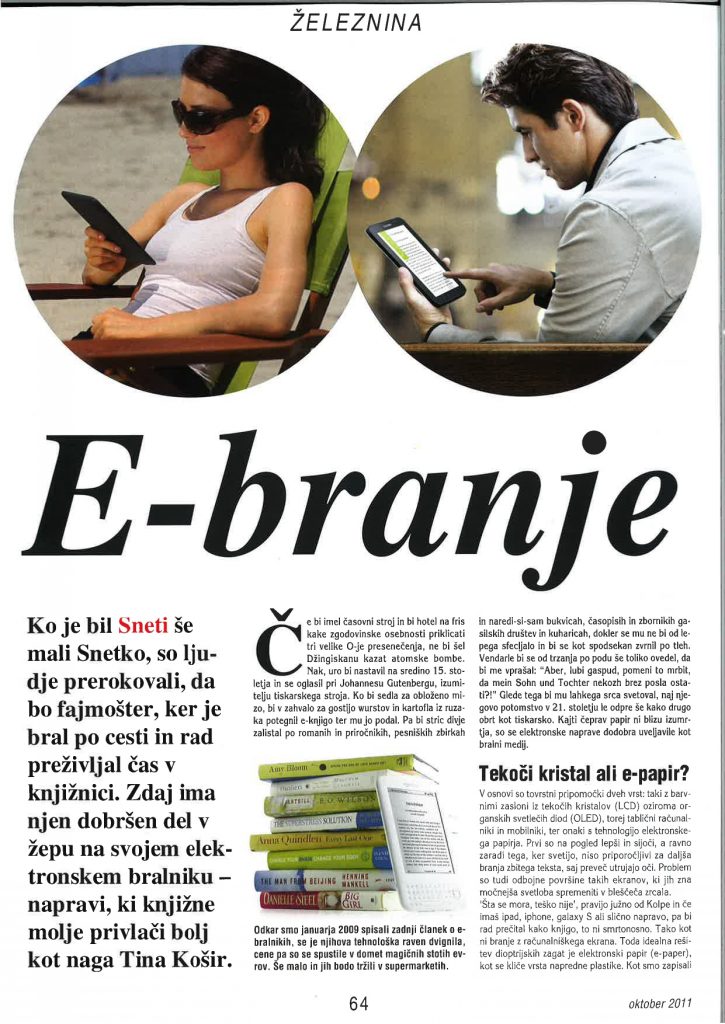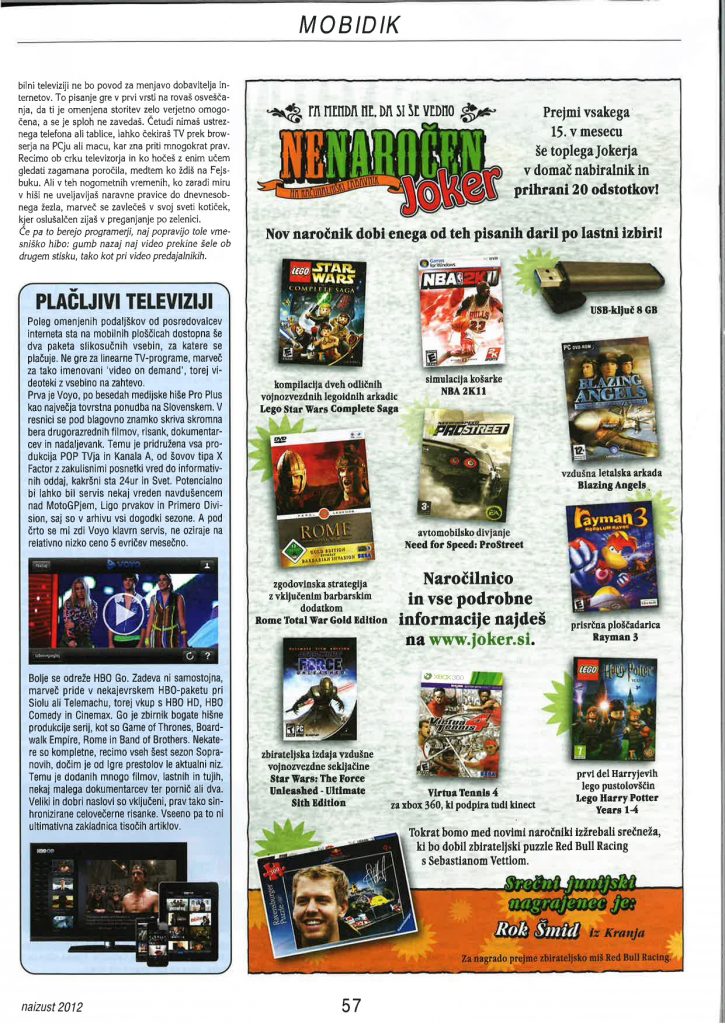Exhibition “The Fight for the Slovenian Language”
21 May – 2 July 2019, Faculty of Arts, University of Ljubljana
THE DRIVING FORCES AND GUARDIANS OF THE DIGITALIZATION OF THE SLOVENIAN LANGUAGE OVER THE PAST 40 YEARS HAVE BEEN ENTHUSIASTS AND VOLUNTEER ORGANIZATIONS.
Just as in the nineteenth century
We were once again on the brink of an “industrial” revolution, one that has rapidly transformed society and integrated new technologies into daily life before we could fully adjust.
When home computers found their way into living rooms across mountain passes in the mid-1980s, one of the first instincts among local users was to write programs in Slovenian and share them with like-minded enthusiasts. This was driven by the thrill of making a machine ‘speak my language.’ Enthusiasts then began publishing computer magazines, dedicated media outlets for articulating this new phenomenon in their native language. The next step was developing keyboards with Slovenian diacritics. Since printers did not support these characters, tackling this challenge became yet another project for passionate individuals. Such was the joy of bringing Slovenian into the digital world.

1986 Primož Jakopin created the text editor Ines, after which the company Tipro named a fully-fledged Slovenian keyboard. In order to print with Slovenian diacritics, Jonas had to extract the brain (microchip) from a dot matrix printer, reprogram it (hack it), and insert it back. For each printer individually. This gave rise to an entire industry of home enthusiasts—so-called ‘privatniki’—who, through classified ads, ensured that a generation confidently entered the new technological era.
1991 the first version of the Linux system was released, sparking the open-source movement. In Slovenia, the pioneers of this movement were members of the Lugos association (f. 1996). Their main mission was to provide computer education in the local language and to translate free software. With the explicit goal of enabling Slovenians to use the latest programs in Slovenian, an army of volunteer translators began introducing breakthrough concepts in the small Alpine language that had never been encountered before.
1992 the magazine Joker began its publication. At first glance, it seemed like just another adolescent collection of stories about games and machines, but it chose to focus on language as part of its core mission and editorial policy. Two generations of geeks grew up reading some of the juiciest and most creative prose of the 1990s. Sneti, Febo, and Quattro are personally responsible for scrambling our linguistic neurons with their playful and inventive use of language, including terms like tlačenke, natlačenke, and other quirky expressions of the juicy ’90s.
1995 the technological revolution brought a leap of biblical proportions—Microsoft funded the translation of the new Windows 95 operating system into local languages worldwide. To achieve this goal, translators had to invent iconic terminology that would change the homes of everyday people. This marked the dawn of the modern information culture.
2001 Wikipedia was created, the first free encyclopedia. Shortly after, the Slovenian version was launched, once again initiated by a group of enthusiasts. With full awareness and in memory of the encyclopedists’ associations, they maintain the Slovenian Wikipedia, which was one of the first to be localized and, for several years, among the largest in terms of content.

…and unfortunately, the future is not as bright as the past
Today, Slovenian is regressing in a globalized world because there is simply too much work and responsibility for enthusiasts to sustain. Consumers daily notice that Slovenian is no longer a first-class citizen of the world: Amazon Kindle doesn’t support books in Slovenian, and Apple phones know Croatian but not Slovenian.
With Unicode, the international universal standard for encoding all characters that have ever existed in any language, today, in 2019, we cannot print Prešeren’s Poezije because no one has filled out the form to include the ‘metelčica’ and ‘danjčica’ characters in the standard. Therefore, this year, we will take care of it at the Computer History Museum Slovenia, in collaboration with Dr. Primož Jakopin.
Exhibition authors: Boštjan Špetič, Borut Kumperščak, Mateja Pucihar Baebler (curator), Mitja V. Iskrić, Gaja Zornada, Marko Štamcar, Artur Švarc, Dare Hriberšek
Design: Vesna Krebs
Acknowledgments: IOLAR, Aaron Marko, Jaka Stele, Primož Jakopin, Miran Hladnik, Peter Scherber, Miha Mazzini, LordFebo, Sergej Hvala, Damjan Popič, David Pahor, Borut Rismal, Milan Čelan (Tipro)
INES & Ines

The 1980s were the years when computers crossed the thresholds of institutes, universities, and large companies, and were widely adopted into homes. The personal computer became a common part of many living rooms, even in our country. One such computer was the ZX Spectrum (1982) from Sinclair. Prior to that, the company had already produced the very popular ZX80 and ZX81.
Due to its price (in England, it was sold for £125, and the 48kB model for £175), the ZX Spectrum was accessible to a wide circle of computer enthusiasts. This included many of our own! Its compact size made it perfect for hiding in various secret corners of cars with Yugoslav license plates at the borders of our former homeland. In mid-1984, the computer magazine Moj Mikro even estimated that there were already several thousand of them in Ljubljana alone (!). Most users employed it for gaming, with more and more games becoming available each month. However, the enthusiasm of the locals eventually turned to frustration, as they missed many TV news broadcasts. The only television in the house was monopolized by the kid and a few of his friends.
Some ZX Spectrum users recognized the opportunity to write their own useful programs or even games. If the program they had didn’t meet their needs, they simply wrote a new one.
The INES system
One of these enthusiasts was Primož Jakopin, who discovered his passion for writing computer programs during his student years. Throughout his career, he wrote IBIS (Integrated Hospital Information System), BIOS (BioMedicina Slovenica), and text editors such as BESS (Basic Editor for the Sinclair Spectrum, 1983), TESS (Text Editor for the Sinclair Spectrum, 1983), INES (Information Editing System, 1983), EVE (Event Editor, 1986), and STEVE (ST Event Editor for Atari ST, 1986). And why did he focus on writing editors? Jakopin explains that it was because there were no good ones available on the market. However, he adds that he needed a language that would allow him to manipulate and edit data with macro commands.
The INES system, in addition to its text editor (like its predecessors), also offered the ability to manage small databases, incorporate images into text, and perform word analyses. The text editor even allowed for the selection of diacritical marks. Users could print their text in eight different fonts. With INES, you could create a list of all the words in a text, organize them, calculate how often a particular word appeared, find the longest word, and more. Aspiring poets especially appreciated the reverse (O) command. With it, they could first scramble the words, sort them alphabetically, and then reverse them back to their original order. This gave them a list of words alphabetically sorted by their final letters, not the usual starting ones. This made finding the right rhyme much easier. Another very useful command was the N command. It allowed users to add recipient data to a letter intended for multiple recipients, printing out a personalized letter for each recipient. The template for the letter and the list of recipients were stored in the same file.
INES was truly a useful system, a fact that was also recognized abroad, particularly in Germany, where around 400 copies were sold.

INES Keyboards
The affordable price of the ZX Spectrum for the end user was very important for the Sinclair company, and the keyboard was designed with this goal in mind. While the rubber keys became the trademark of this computer, for users who used the Spectrum to write computer programs, they were a real nightmare. Erasers, after all, serve a different purpose.
The INES keyboard aimed to spare more advanced users of the ZX Spectrum from losing a few grey hairs. The name of the keyboard was chosen in collaboration with Primož Jakopin, as it was sold alongside his INES text editor. It was manufactured at the Institute for Electronics and Vacuum Technology, with the design concept provided by Sašo Albert. The prototype was available by the end of 1984, while the final version became available to customers in early 1985 (although they had to wait about a month for delivery). It was definitely worth the wait. The keyboard was visually on par with its foreign competitors. The labels on the keys were engraved, the numeric keypad executed INES system commands, and there were even keys for č, š, and ž. On the back, there were connectors for a monitor, TV, cassette player, etc. And how was the INES keyboard connected to the ZX Spectrum? That’s a question from this century. Back then, however, users had to be a bit more skilled— they had to install the computer into the keyboard themselves.
This story also enjoyed success abroad, as it was sold in the Italian, Austrian, and German markets.
OKNA 95
The 1990s mark the collaboration and adaptation of a global revolution: in 1995, Microsoft Slovenia carried out the first complete translation of any operating system. Okna 95 (‘okna’ meaning ‘windows’ in Slovenian) became the most widely used operating system during the peak of computerization, leaving a profound impact on modern language.

Breaking New Ground in Our IT Terminology
Software translation into Slovenian began in the 1980s thanks to enthusiasts and volunteers. However, some of the later translations of Microsoft products are considered the foundation of today’s IT terminology. We spoke with David Pahor and Simon Bratina, who, in those legendary times a quarter of a century ago, were part of the first team of professional localizers from Atlantis, now IOLAR.
Where did the idea of translating software products originate? Was it a love for language, or did the need simply arise in the market?
It was a combination of a love for language and the needs of the then largest global software provider, Microsoft, which correctly recognized the advantages that translating their key products into Slovenian could bring. It all started at our company, Atlantis Publishing, which was a Microsoft partner and distributor for our region. The director, Borut Rismal, as always, had the foresight to see things that others couldn’t, and he managed to convince Microsoft that this was the right path. This was also because, at that time, IBM was making significant inroads into our market with its localized products, particularly within the public sector.
At that time, Microsoft had its localization center in Dublin, and the team there came to visit us, essentially for a reconnaissance. They saw that Atlantis had the staff for such projects, as we were system integrators. Furthermore, we demonstrated how we had already unofficially localized Word 6.0 before the official translation. Word, in fact, was relatively easy to adapt linguistically.
So, it all started with the translation of Word?
Yes, at that time our goal was to show that it could be done. It was mostly an engineering task, and somewhat less a translation one. A lot of questions came up because Word was an application within the operating system, borrowing certain parts of the user interface from there. In short, it wasn’t as simple as it might seem at first glance. We finished the project at the end of December 1994, and Microsoft later published the Word translation. This established our infrastructure and, more importantly, built our relationship with Microsoft. We convinced them that we could handle these tasks flawlessly. Therefore, it was never in question who they would choose moving forward.
It’s important to note that this was happening in 1993, at a time when there was no Slovenian branch yet. It was established a year later with just three employees, who immediately became actively involved in our work. The first product we localized through them was Windows 95, followed later by Office.
Slovenian was the least spoken language in the world into which Windows was translated at that time.
Yes. Later on, some more niche languages were added, but at that time, Slovenian was quite unique.
What does the translation process actually looked like in practice? Are there specific tools, or do you have to manually go through the system searching for text to translate?
Of course, Microsoft had localization tools—programs that extract translatable text from the user interface for translation. These tools were advanced enough to include integration with a spell checker, which at the time was provided by the Slovenian company Amebis.
You probably had to establish some principles or guidelines on how these translations should be done, right?
There were two levels to this: first, project management, which had to be precise in terms of both content and the timelines set out in our contractual obligations with Microsoft. The second level was the specialized terminological and translation work, which faced entirely different challenges compared to managing the project overall.
Are there any expressions that originated from these projects, which are now completely commonplace today?
One example is splet, today’s term for the internet. At that time, we had quite a few discussions about alternatives; the main one was veb, a Slovenian adaptation of ‘web,’ but splet ultimately won out and, as we can see, it stuck. Another interesting term was mestodržec, which was considered as a translation for ‘placeholder’ in Word, but we eventually changed our minds. For ‘boot,’ meaning to start a computer, we briefly wanted to use obuvanje (putting on shoes), since it metaphorically refers to preparing for a task. However, we also abandoned that idea.
Did language experts also participate in this process?
Of course, most notably Janez Gradišnik, a Slovenian writer and translator, and Peter Weiss from SAZU, along with many other linguists and translators. In a way, David also contributed—though not a linguist by profession, he is known as a computer expert with a strong passion for the Slovenian language.
How long does such a localization take? I don’t think anyone really has a good idea of how much text is involved in this process?
It depends on what we’re talking about—Word, Office, or Windows? It was often at the level of a decent-sized book. It’s important to note that back then, besides Word, you also got a special booklet that was specifically designed and printed. As for the programs themselves, there weren’t many words, but there was an exceptionally extensive user help section. In those days, the internet didn’t exist, so all help was bundled with the application or operating system on the computer. Today, help is minimal, everything is linked to an online database, which is much easier to update, modify, and distribute.
To answer the question, a product like this had several hundred thousand words to translate. Windows, for instance, and Word had a bit fewer, while Office, with its extensive help section, had even more. The production cycle didn’t start with the translation itself; it began with a month or two of preparation by the engineering team in Dublin. These were the people handling the version preparation, installation programs, and testing. Then came the localization and translation phase, which for an operating system like that took about three months, followed by testing, which also took a couple of months. So, the whole process took around nine to eleven months. For larger projects, like Office, we hired additional external collaborators to ensure timely completion. In later versions, Microsoft partnered with the German company Trados, which had just developed computer-assisted translation, speeding up the process a bit.
How were the translations received by the public?
Overall, the translations were very well received, although some in the tech community scoffed simply because it was translated. However, when we asked them for specific reasons, we didn’t get any constructive arguments. Over time, most of them accepted it. Even more importantly, the general public—those who don’t make their living in the IT industry—embraced it. In short, sales went excellently, and that was the litmus test we passed. The goal was simply to make computers accessible to everyone, not just tech professionals. There was no widespread resistance.
Do you think that was the golden age for the Slovenian language in computing? Today, Microsoft often resorts to rather laughable automatic translation for help content.
That’s true. It’s incomparable to today’s times. In the mid-nineties and early 2000s, the quality of translations in this field was much higher because experts had a direct hand and influence over the process. Consumers were also more demanding of providers, and their sales were much more dependent on the availability of products in Slovenian.
As it was later unofficially revealed, the budgets for localization were significantly reduced. Microsoft, it seems, managed to outpace IBM in the public sector with long-term contracts for office software, and there was probably no longer a need for such projects. In the last decade, for example, they have abandoned local translation companies. The concept has changed now.
In addition to the downsides for consumers, it’s probably also a loss that the continuity of the terms used is being lost.
That’s right. The terminology we established through long and thoughtful discussions has been replaced in recent years by other terms in some places. And not because the new terms are better, but mainly because the people responsible weren’t part of those discussions. We were often forced to come up with entirely new terms just to avoid overlap with others. When today’s translators encounter such a situation, they probably see it as unnecessary. In this way, we first lose clarity and then, over time, lose care for our language.
Do you think that localizations will eventually come to a complete stop? Nowadays, many of us speak foreign languages?
Our opinion is that this should be increasing, especially for languages that are less widely spoken. We even believe that the state should take more responsibility for this. Especially for commercial products, that is, those that we, the consumers, pay for, there should be insistence on ensuring they are localized.
These projects were important because they helped create and define Slovenian terminology for the IT field. In this way, students are introduced to local terms for specific concepts, and the language evolves. And, mark this down: our efforts at the time and their consequences were, quite simply, state-building.
Is there currently any word translated into Slovenian that annoys you?
Sure, there are words like that, but right now we don’t have any specific ones in mind. Just like soldiers, who become somewhat numb after all the bloodshed they experience, we too have become a bit numb after all these battles, and we no longer react to every little complaint.
Joker
In the golden pioneering era of Slovenian computing, we could only follow computer games in Slovenian through the magazine Moj Mikro, until 1992, when Joker first appeared as a prototype in a grey-blue color, later as a supplement to Moj Mikro, and eventually as an independent magazine.
Joker was more than just a magazine about computer games. Its added value also came from stories that weren’t entirely focused on computing. In short, from the very beginning, Joker was a computer entertainment magazine that, despite ceasing publication in the fall of 2017, remains unique and unparalleled in the Slovenian magazine market. The team of enthusiasts, known by their partisan pseudonyms like Lord Febo, Sneti, Quattro, Agressor, and others, who formed the Joker Cream Team, also changed the Slovenian language. In their writing, they used everything from the oldest and most forgotten archaic words to the wildest neologisms – the guys invented a whole bunch of new Slovenian words or cleverly ridiculed existing ones in an extremely intelligent way.
The style that characterized Joker’s writing is unmatched. Creativity and linguistic upheavals were present on practically every page of Joker, and many readers picked up the magazine even if they weren’t directly interested in the games.
Joker resisted for a long time the era when the internet set new rules for the media. The small market, the new generation of digital readers with different habits, and the industry’s lack of interest in advertising support dealt a fatal blow to the colorful magazine, leaving its readers deprived of new adventures.
Legends are what they are because they can’t be erased. And Joker, Joker is a legend.











